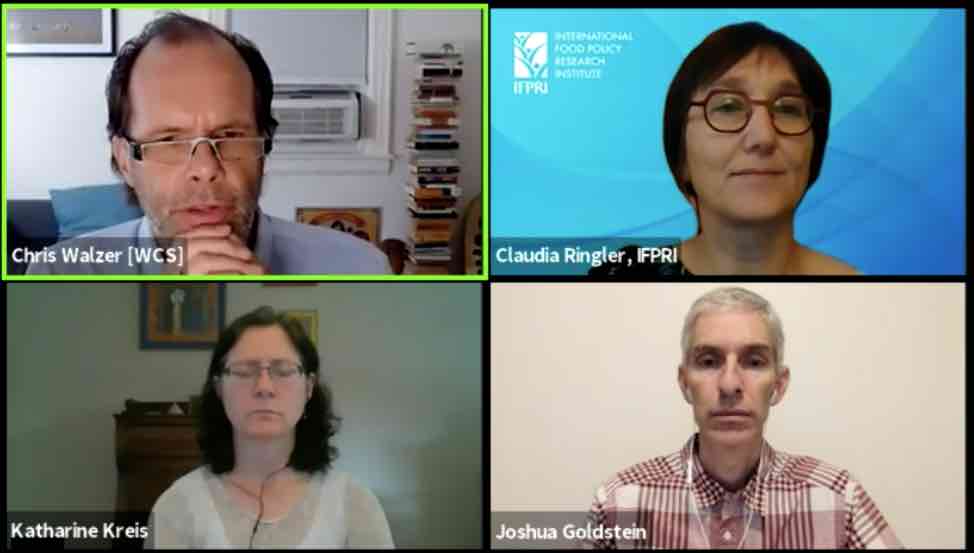The COVID-19 pandemic—which originated when the novel coronavirus jumped from an animal population to humans, and was found in a wet market in Wuhan, China—raises many questions about the risks of such zoonotic diseases and the food system. Should we minimize the risk of zoonotic disease transmission by reducing our reliance on animal proteins? Or would it be more effective to reduce climate change impacts from food systems given their likely contribution to future zoonotic disease risks?
An Aug. 18 IFPRI virtual policy seminar addressed these and other critical questions on the interactions between ecosystems, food systems, and public health. Agricultural drivers are responsible for more than 50% of zoonotic infectious diseases that have emerged in humans. But with effective policies, agriculture and food systems can play a vital role in preventing such outbreaks.
One CGIAR is currently developing a new research strategy to achieve its vision of ending hunger through science to transform food, land, and water systems in climate crisis. After an introduction by Claudia Ringler, Deputy Director of IFPRI’s Environment and Production Technology Division, speakers explored the agriculture-ecosystem health interface and zoonotic disease risks in light of the pandemic.
Since livestock were first domesticated starting thousands of years ago, many diseases moved from wild animals to humans. In fact, 72% of all zoonotic emerging infectious diseases originate in wildlife. Now, the frequency of emerging infectious diseases is on the rise, said Christian Walzer, Executive Director of Wildlife Health at the Wildlife Conservation Society.
“There are about 50 outbreaks per decade and that rate is increasing. There have been 11 outbreaks of Ebola in the DRC [Democratic Republic of Congo] since 1976, eight of those have occurred in the last 13 years, and in the past two years, four of them have occurred,” he said. The dramatic increase in the movement of people and goods around the globe has amplified these kinds of transmission risks, he said.
Global development pressures also play a role. “Land is in demand by both people and natural ecosystems,” noted IFPRI Research Fellow Ricky Robertson. Claiming land for food production reduces forest cover and animal habitats, which in turn increases the risk of disease transmission between animals and humans.
Robertson and colleagues have expanded IFPRI’s IMPACT model, used to analyze the global agricultural economy, to understand the extent of cropland and forest interactions. Their recent analysis found that climate change reduces forest cover more than incursion by cropland. International, interdisciplinary research is required to address land conversion and ecosystem displacement at a global scale, he said.
Forests are the key interface between humans and infectious diseases transmitted from animals, said John E. Fa, a Senior Research Associate at the Center for International Forestry Research (CIFOR) and Professor of Biodiversity and Human Development at Manchester Metropolitan University. Fa’s research team is using biogeographic models to determine the distributional probability of viruses like Ebola. They have found that deforestation is a strong driver of Ebola transmission and a strong correlation exists between human disturbance, deforestation, and zoonotic disease spread.
The challenge is to develop prediction tools for disease prevention and facilitate quick responses in areas prone to disease outbreaks, Fa said. Early warning systems must be developed on an international scale to facilitate cooperation and build on local solutions.
Katharine Kreis, PATH Director of Strategic Initiatives and Lead for Nutrition Innovation and Bridge Collaborative Secretariat Member, spoke about the role of next generation technologies for food production. Cultured proteins produced through cellular agriculture (cell cultures made using biotechnology and other means) are an innovative way of meeting the world’s growing demand for animal-sourced foods, with impacts for health, development and the environment.
“We think there is probably a market entry point into into humanitarian relief operations in low- and middle-income countries to improve the quality of those foods,” Kreis said.
The Bridge Collaborative has studied the potential of cultured proteins, including the policy and regulatory environment required to foster the new technology, the implications for public health, agriculture, and the environment, and the development of a related carbon offset program. Although the broad development of cultured protein technologies is only in its initial stages, interest in these products is growing, Kreis said.
“We radically and urgently need to change our relationship between food production and the ecosystems that support it,” said CGIAR Research Program on Water, Land and Ecosystems (WLE) Director Izabella Koziell. International cooperation, research development, and innovation should focus on three key areas, she said: Increasing dietary diversity; developing a modern approach to sustainable intensification; and ensuring better returns for multifunctional landscapes.
A systems approach is key to addressing the COVID-19 pandemic, said Bridge Collaborative Director Josh Goldstein, with The Nature Conservancy (TNC). Project teams focusing on the crisis must be empowered to pursue integrated research and funders must drive innovative, multisectoral solutions linking environment, food, and health outcomes.
“Land use and agricultural industry change, sustainable forestry, biodiversity, water depletion, therefore, continue to be important research areas to focus on for the food and nutrition systems research,” said Eva Ohlsson, Senior Research Advisor for the Swedish International Development Cooperation Agency (SIDA). CGIAR institutions should focus on the encroachment on natural ecosystems and resulting risks of zoonotic outbreaks, she said.
Speakers agreed on the need to reduce the consumption of animal-sourced foods in high-incomc countries due to their climate impacts, but also emphasized the reality that many people, particularly in middle- and low-income countries, produce and rely on meat products for nutrition and livelihoods. Making a radical transition to eliminate animal-based foods would not be wise, Koziell said. Instead, efforts should focus on building greater dietary diversity, particularly on more nutrient dense foods.
These challenges present a unique opportunity to develop multisectoral collaborations with nutritionists, agriculturalists, and environmentalists. “One Health approaches are fundamental,” Fa said.
Hope Zabronsky is an Intern with IFPRI’s Environment and Production Technology Division.







